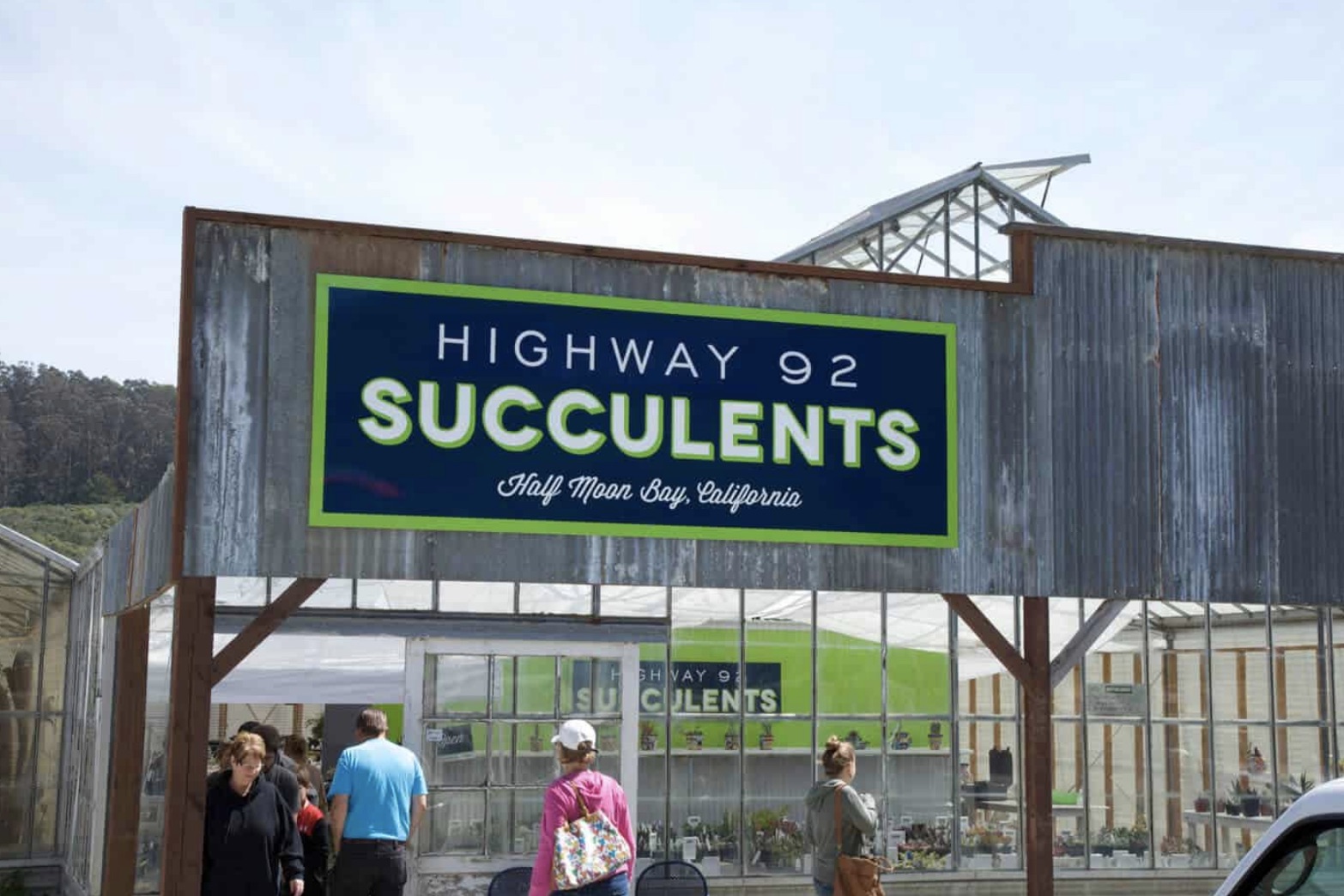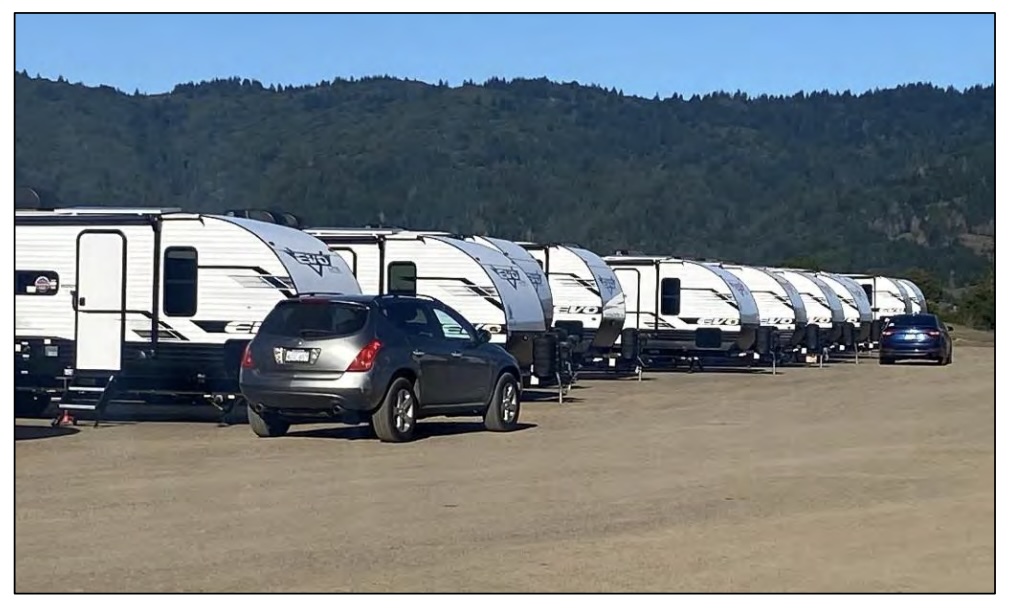|
Getting your Trinity Audio player ready...
|
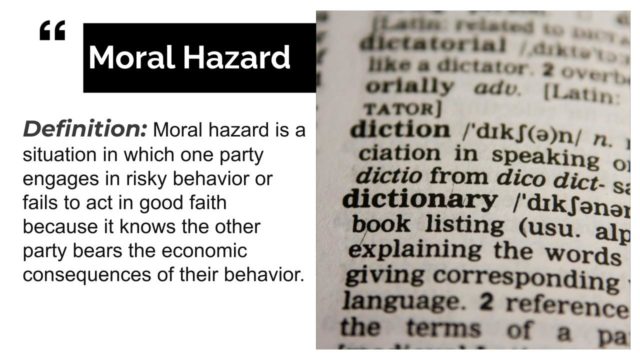 OWN VOICE. ~ InPerspective by Gregg Dieguez —
OWN VOICE. ~ InPerspective by Gregg Dieguez —
It’s ironic that a seawall intended to defend against a natural hazard is turning into a moral hazard as well. Pacifica’s $125M Beach Boulevard Infrastructure Resiliency Project (BBIRP) includes work to just leave stuff where it is, regardless of Sea Level Rise (SLR). This raises the questions described herein. The hope is that Pacificans will be able to decide for themselves where the balance of benefits and risks are, and what actions they want to take, and pay for.
Footnotes: to use, click the bracketed number and then click your browser Back button to return to the text where you were reading.
Images: Click to enlarge for improved readability in a new window.
Situation: Pacifica is proposing a seawall for the Sharp Park neighborhood, to protect against sea level rise (SLR). The City has proposed a sewer rate increase which includes that seawall, as well as refurbishment of the Sharp Park Pump Station(SPPS) – at its current location. The City proposes to borrow $83,959,000 for additional funding (plus $73% in borrowing costs) because the rate increase itself is insufficient for the $125M of infrastructure required[1]. This article explores the issues surrounding that proposal and the implications for Pacificans.
The Sewer Rate Increase: Let’s get this part out of the way quickly. The increase is NOT a tax. Prop 218 was created in part to allow these types of fee increases without a full popular vote. It can only be stopped if >50% of Pacificans object in writing by May 9th. Based on my analysis of Pacifica’s sewer financial condition a fee increase IS NEEDED. And the increases proposed are likely not high enough, especially when a seawall is added into the costs. I will cover this in more detail in future articles, but in brief, Pacifica probably has $300-400M in sewer assets (at current replacement cost). Those assets are likely over 50% into their lifetimes, and the imbalance between City reserves to replenish them of about $7.7M, and the looming needs, is massive – as it appears to be for Public Works agencies all over the Country. The needs of the Sewer System are valid, and include major refurbishment of the SPPS, upgrading pipes to prevent more overflows (at ~$2M per mile) and upgrades to the Calera Creek sewage treatment plan including new technology for last stage purification ($11M) because of obsolescence of the UV ‘sterilization’ ‘light bulbs’.
However, the major issues in dispute are: how much money is needed, where should it be spent, and who pays for it? In one slide show I saw, the City deferred two things from discussion: Who Pays, and consideration of a suite of alternatives to a sea wall. Therein lies the moral hazard. “Moral hazard” is a term used in the insurance industry to describe situations in which people may be inclined to take bigger risks if they are insured than if they’re not. It arises when someone has limited responsibility for the risks they take and the costs they create. This appears to apply in Pacifica.
What’s All This About Sea Level Rise?
Certainly other governments have built dikes and seawalls to defend against rising seas. The difference between Pacifica, where about 1% of the homes are at risk from sea level rise by year 2080[2], and Holland and Foster City (where people agreed to fund bonds to protect themselves), is that in those situations, the vast majority of properties were at the same risk. In Pacifica, it’s a small % of the homes who will benefit, yet the entire City is being asked to fund the protection. The justification is that a seawall also protects the SPPS in its current location, and that a fair share of that protection ($40M) should be paid by all. That last assertion is open to question. Special assessment districts, wherein the affected area funds its needs when they differ from the rest of the community, are common. Further, the SPPS could be relocated to safety more permanently. Finally, the SPPS might also be part of a special assessment, levied only on the properties who require it. So why has the City chosen this path forward now, and ignored other alternatives for shoreline protection as recommended by the CCC? In fact, Pacifica is ALREADY an example of successful soft solutions, at Pacifica/Linda Mar Beach as part of a flood control project at San Pedro Creek.[3]
The issue of coastal protection in Pacifica is contentious, to say the least. But we have long known that living on the edge of the ocean invites disaster.[4] Draft policies in Pacifica to address sea level rise & erosion are part of a long back and forth with the California Coastal Commission(CCC)[5], and in 2019 the incomplete LCP update process was bundled with a General Plan update under Plan Pacifica: https://www.planpacifica.org https://www.planpacifica.org/local-coastal-program But the City and the Coastal Commission seem to be not listening to each other. The City has made it clear that it will protect existing neighborhoods, and now we’re starting to see the costs. And that City strategic restriction is consistent with the bounded alternatives studied by consultant GHD, which included a “No Action” scenario, and other ways to “hold the fort”, but nothing like the CCC guidance.
Note that in HMB, where the creation of the Pillar Point Harbor breakwater in 1960 caused erosion on nearby beaches, the Harbor District consultant (also GHD) recently pushed riprap or other forms of armoring, but CCC staff preferred a “soft solution”. Eventually the Harbor Commission brought in consulting firm ESA, who provided the vegetated dune design now being installed at the West Trail Living Shoreline Project. It’s new/experimental and many up and down the state are watching to see how it will hold up. Another alternative was surfaced by Dan Haggerty of the MCC, a sand retention device being used in Africa, and other places. There are other approaches such as THIS [6], but Pacifica has chosen not to consider them.
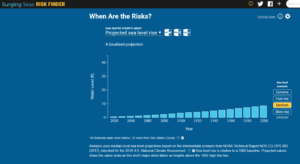
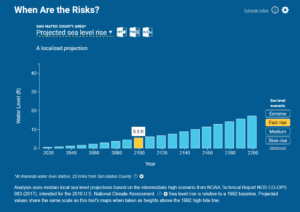
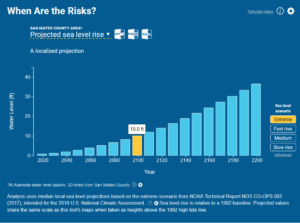
And how realistic is ignoring the effects of the Climate Crisis? How long can it be ignored? There are many forecasts of the degree of sea level rise Pacifica will face. The City’s analysis is targeting 2 feet[7], and suggests a 50 year life “A design life of 50 years has long been a default value for civil infrastructure projects based largely on the durability of commonly used construction material and degradation in the marine environment.” Note that this is less than the 3.3 feet in the San Mateo County study’s mid-level scenario. Note also that one of the Pacifica sewer studies uses a 3.74″ “design rain storm”[8], in spite of the fact we got 7.49″ of rain in a day last October, and nearby coastal areas had 6″ storms throughout the fall/early winter. So it seems Pacifica’s study understates the risks on several fronts, yet assumes only a 50 year lifetime for the investments. There is a key difference between sea level rise and other intermittent risks, like earthquakes, tsunamis, and wildfires. Once sea level rise gets here, it’s never going away, at least not for thousands of years. So I suggest a different level of risk tolerance is necessary. Keep in mind that what used to be ‘100 year storms’ happen more frequently. This study says that “‘100-year’ floods will happen every 1 to 30 years,“. One (1), to 30!! Note that Houston had 500 year rainstorms… 3 years in a row. A probability of 8 in a Billion! The Climate Has Changed. Even if the seas only rise slowly, the storm surges are going to be bigger and more frequent. Look at the 3 scenarios of sea level rise (above) in San Mateo county. Sewer pipes have lasted (with repairs) up to 100 years. Why would you design a solution that won’t last into the next century? And if 10′ SLR by 2100 is possible, and 15 feet by 2200 in the Fast Rise Scenario, why burden future generations with doing this work over and over?
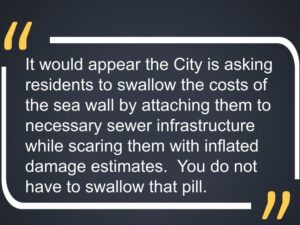 Are The Damage Costs Overstated?
Are The Damage Costs Overstated?
The BBIRP analysis is filled with inflated dollar amounts that attempt to sway readers into thinking the requested infrastructure investments are reasonable. Property values in the hundreds of millions are cited. But hold on: how much of that money is really the City’s risk, and how much of that belongs to homeowners and their insurance companies? 74% of the Monetized Primary Impacts[9] are from property values, and an additional 13+% is from sewer assets that could be moved. Put together, a total of 87% of the primary risks won’t be paid by the City if they just relocate the sewer. And a lot of the secondary costs are costs to businesses in disruption, but those are NOT City or resident losses. Further, those economic impact numbers extend out to 2100, but the analysis for the rate increase doesn’t extend out to 2100 as well (only to 2032), showing the compounding costs of debt and the additional costs to replenish the first generation of the ‘rescue assets’ built now[**]. The monetary analysis is not a fair apples to apples comparison, and as pointed out above, it omits valid coping strategies that the Coastal Commission and other jurisdictions are recommending.
The impact of sea level rise becomes a moral issue that can be tough to wrestle with, but how many times are you willing to pay to rebuild New Orleans or Florida in the face of hurricanes? Why should people who put themselves in harm’s way consume resources in repeated rebuilding that we can use instead to fight the Climate Crisis, or reduce the Unfunded Pension Liability, or correct the trillions of dollars in infrastructure deficits, all of which we are about to hand to future generations? The money that is really the primary risk for the city is the loss of tax revenues and fees for water and sewer, minus the costs of providing those services to the homes that will be lost. GHD did not care to analyze the true incremental financial risks to the city.[10] Besides the moral questions, a key omission in the GHD analysis is the ROI (Return On Investment) to the CITY of the SLR adaptation investments it proposes to make.
Note further that some of the hazard claims are not really valid. The City is not “losing a beach” without a seawall. The beach is MOVING. In fact, even GHD admitted “As the existing seawall is demolished due to damage and the shoreline naturally erodes, this process will introduce sediment to the littoral zone and potentially result in a seasonal sandy beach at the toe of the bluff. Although it will likely be narrow and seasonal, like beaches north of the Project area, it may provide seasonal beach access for recreational purposes and improve the chances that beach can adapt to SLR.” [11] Did you catch that? Pacifica isn’t losing a beach, it’s just getting a NEW beach.
And strangely, inconsistently, the GHD analysis admits it’s incomplete, and hints that a Special Assessment District should be adopted for other neighborhoods: Page 59: “The market and non-market values of adjacent resources such as Laguna Salada, Sharp Park Golf Course and Shoreview neighborhood were not included in this assessment because those impacts would depend on the adaptation strategies implemented by those property owners.”[emphasis added] Which is a clue that affected property owners should take these actions and not have them underwritten by the City.
Paying for Doomed Development:
It would appear the City is asking residents to swallow the costs of the sea wall by attaching them to necessary sewer infrastructure while scaring them with inflated damage estimates on properties for which most of Pacifica is not responsible. Pacifica is repeatedly following a strategy of Doomed Development, permitting construction on landslide-prone hills and in flood and tsunami plains, and appearing to expect someone else to pay for the inevitable damages that result from Parasitic Profiteering. That is the Moral Hazard here. The immediate questions are, will the owners of those properties pay for those damages? Or insurance companies? Or will the rest of Pacifica have to pay? Can you get the State to compensate for those losses? I would point out that the new County parcel tax to address sea level rise might be another source of funding for restitution or for SLR mitigation, but if Pacifica’s leadership continues doing Doomed Development, I doubt the County will provide rescue funding for it. I would certainly oppose bailing out Doomed Development. Were I the City of Pacifica, I would only permit development on an ‘at risk’ basis, meaning: if you develop in these vulnerable areas, you have to pre-fund insurance sufficient to clean up the mess when your property is destroyed, and sufficient to cover any losses you cause to those around you (e.g. in case your home slides downhill). The City already had to foot the bill for one property when it went bankrupt. That mistake must not be repeated.
And what about the current homeowners at risk? Were they warned about the risks when they purchased their homes, as I was regarding flood zones when I looked at properties? Does the State (via the CCC) bear some liability for providing restitution to property owners when the state permitted their construction in the coastal zone? Those are avenues I would explore on their behalf. If your government allowed Doomed Development, then it certainly must compensate for damages. Of course, last Oct. Gov. Newsom vetoed a bill that could have compensated property owners for losses.[15]
Some More Questions I would ask:
1. Is the $3.8M relocation of the sewer mainline at SF RV Park something that should also be a Special Assessment District?
2. The CCC provided the City a grant to write the LCLUP. The deadline expired, even after extension. Is that money wasted?
3. Does Pacifica have the money to replace its seawall every 50 years?
4. Why burden future generations with borrowing costs that add 73% to the cost of each asset?
5. What are the TRUE financial impacts to the City, as opposed to property owners, and what return on investment results from saving those assets?
6. Why commit to debt immediately? Why not explore the grants that One Shoreline, FEMA and other agencies might provide? Pacifica may not qualify as a disadvantaged community, but it is a recognized precious scenic and recreational asset, it’s on a key transportation route, and the City should have grant leverage because of those characteristics. Besides, Asking Isn’t Stealing. Ask what the City must do to qualify for grants, before committing to unnecessary debt.
7. Does it make sense to get a rate study from a consulting firm with ties to the lending industry?
8. Will the sea wall cause a wave energy rebound that affects other areas of the city, such as increasing erosion on the bluffs west of Palmetto?
9. Didn’t the City already try, and fail, at armoring those bluffs? Are we learning from our mistakes?
10. Why aren’t the costs of sand nourishment fully included in the alternative analysis, for as many years as the economic hazards are detailed? They were in the 2018 study…[12]
11. Why have the City pay to protect some residents and NOT others in the Laguna Salada, Sharp Park Golf Course and Shoreview neighborhood? Why not be consistent and let every neighborhood fund its own adaptation measures? Perhaps because those areas can’t be used to make a case for a sewer rate increase?
12. What are the economic consequences and property value impacts of building a sea wall that people can’t see over to enjoy the ocean view?
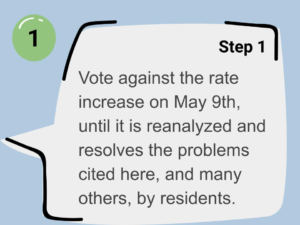
What Could Residents Do?
First, have the City listen to the Coastal Commission and evaluate coastal protection options using the emerging suite of coastal adaptation strategies. However, in order for the City to change its strategy, Pacificans will likely have to change their leadership. And here are some options for resident action:
- Vote against the rate increase on May 9th, until it is re-analyzed and resolves the problems cited here, and many others, by residents.
- Appeal to the CCC to deny the sea wall, and the new LCLUP.
- File lawsuits against the City. I understand that gets expensive, but is already being done for some bad planning decisions which are pending.
- Institute a Recall Election for Council Members who are taking action you oppose. That is probably no more expensive than lawsuits, but November is coming soon, so I’d limit that only to Council Members who vote in opposition to your wishes and are NOT up for fall election.
- In the fall elections, vote out the council members endorsing approaches you oppose. Keep in mind the the Real Estate Industry donates heavily in favor of several of your pro-Doomed Development council members[13]. This will take concerted effort.
Concluding Thoughts:
The City’s plan is clearly to try to hold the line against rising tides. At the same time, it is permitting other Doomed Development projects elsewhere in the City. The $125M infrastructure plan includes projects to just leave stuff where it is, tides be damned. The studies cite damages out through year 2100, but don’t provide costs of their strategies through the same timeframe. Nor do the studies assess alternative strategies to SLR adaptation that have proven to work, right here in Pacifica.
So we’re back to the title of this article: there is a Moral Hazard at work here. A Moral hazard arises when someone has limited responsibility for the risks they take and the costs they create. The entire city is being billed for preserving a small percentage of the city. And given sea level rise, even that small area is unlikely to stay protected. So why waste the money? SLR is a real hazard. The other hazard to residents is that the City plan has no guarantees, and no funded restitution or remediation if it fails. It’s a hope and a promise, without assurance[14]. The only things certain are that the money will be spent and that 73% extra will be added on to every dollar borrowed.
This is an issue only Pacificans can decide, and it hinges on morality and ethics as much as money. You will have to decide, as a group, whether paying to hold back the tides is a good use of your precious money and a good investment for you and your descendants’ futures.
FOOTNOTES:
[**] Mismatched Evaluation Timeframes: Even the BBIRP cost analysis for the Alternatives stops at 2080, with no explanation I can find for why “Planning Horizon 4” is not detailed. If one is analyzing damages out to 2100, then so should all other financial analyses. To fail to do so is incomplete, flawed, and biased.
[1] $125 Million, plus borrowing costs:
Page 2, Wastewater Rate Study, Bartle Wells Associates (BWA) January 26th, 2022.
[2] – 1% of homes at risk. Table 7-1 pp 55 – 56, GHD | BBIRP Multi-Hazard Risk Assessment Report | 11213162 |
2030 – 27 structures
2050 – 24 structures
2080 – 71 structures
2100 – 43 structures
Total : 165 structures, 122 by 2080 with 12,393 sewer connections in Pacifica. City of Pacifica – Wastewater Capacity Fee Report by BWA, Page 10
[3] Successful case study: San Pedro Creek Case study: “The wetland project not only achieved 100-year flood protection for Pacifica, it also enhanced steelhead habitat in San Pedro Creek and cost substantially less because it required less physical construction compared to other proposed plans.”
[4] History of Pacifica losing homes to the sea: 1983, ‘Old Kneeland house’ in Sharp Park, described here: https://www.thisamericanlife.org/762/apocalypse-creep
[5] Chain of CCC-Pacifica correspondence:
There is likely more correspondence between Pacifica and the CCC than I have seen, but these excerpts provide a flavor of the discourse to date:
11/22/19: CCC writes with history of prior engagement on LCLUP – provides numerous guidelines for advancing a draft to a decent submittal. “Policies should be framed to better balance the dual Coastal Act goals of ensuring safe development and protecting coastal resources such as beaches, habitat, and public access and recreation, as sea level rises over time “ “While armoring may protect existing development in the short- to medium-term, such an approach may not be technically or economically feasible in all areas and/or over longer timeframes, and would not, by itself, be consistent with Coastal Act requirements to ensure protection of coastal resources.”
To CCC on 12/3/20, City sends a complete draft LCLUP.
From CCC 1/12/21: “While we have made progress in prior discussions on the draft LCLUP update, we note that the City did not incorporate a number of edits and feedback provided by Commission staff throughout the City’s review and approval process for this draft update…. it seems that Commission and City staff continue to disagree on the natural hazards and coastal resilience policies and definitions. Without progress on these major differences, Commission staff expects to suggest a significant number of modifications to the draft update. “
Explanation From: Wehrmeister, Tina <twehrmeister@pacifica.gov>
Date: Fri, Oct 15, 2021 at 3:26 PM
Subject: RE: Correspondence with Coastal Commission about LCLUP: “the Council incorporated the feedback from the CCC staff that it felt was appropriate for Pacifica.” [emphasis added]
To the CCC 10/11/21: “The CCC has not cited to any relevant authority to justify its request in this Section 1.” “The City appreciates the extension that you approved on June 3, 2021, to extend the deadline to October 11, 2021, in light of the CCC’s delays in responding to the City’s request for public records.”
To the CCC on 4/15/22: “The City remains unclear as to the adopted regulation requiring this repeatedly requested information and has yet to receive a response from CCC staff citing the regulations requiring this information.”
From the CCC on 4/29/22: “…our respective staffs spent a great deal of time working together on proposed LUP language as this proposed Update worked its way through the City’s processes. In fact, we note that we provided line-by-line suggestions in most cases for the City’s consideration for how best to address potential coastal resource issues …we would appreciate reasoning that is as specific as possible to our suggestions versus the direction the City chose to go in each case,”
[6] Other approaches to sand retention: Presented in Pacifica Sea Level Rise Adaptation Background and Example Strategies(2018). See for example: “sand retention structure includes a series of engineered rock headlands to segment the coast into smaller cells that would be nourished with sand. This concept is shown in Figure 7 below.”

[7] Design Criteria Used for Analysis:
GHD | BBIRP Alternatives Analysis Report | 11213162 | Page 9 “Include capacity for two feet of sea level rise (SLR) in combination with the design event. Ocean Protection Council (OPC) guidance (2018) indicates this amount of SLR is very unlikely (0.4% probability) before 2050 and estimates a 13% probability that SLR exceeds two feet before 2070.”
[8] Design Storm of 3.74″ – page 3-2 Woodard & Curran, Inc. City of Pacifica (0011180.01) Collection System Master Plan August 2021
[9] Monetized Primary Impacts GHD | Multi-Hazard Risk Assessment Report | 11213162 | Page 60: Table 7-3 Monetized Primary Impacts
[10] Analysis Omitted Tax Impacts:
GHD | Multi-Hazard Risk Assessment Report | 11213162 | Page 58 “In addition to changes in property values, property taxes fluctuate and cannot be predicted. The loss in revenue generated by property taxes is therefore not quantified as part of the analysis.”
[11] Improved Beach? GHD | Multi-Hazard Risk Assessment Report | 11213162 | Page 58
[12] 2018 Study Cites Sand Replenishment Costs:
2018 study indicated repeated sand replenishment out through 2100: page 133/242 in App A
“Place sand to widen the beaches seaward of the armoring;
– Investigate sand sources and feasibility of beach nourishment with and without structures to limit sand
transport and amount of required sand
– Widen beach 100 feet and repeat when beach gets too narrow. Estimated nearly 700,000 cubic yards
needed for the 2,600 long Beach Blvd. at a cost of $22 / cubic yard or about $15 million. Three to four
placements by 2050, and about eight by 2100, presuming high sea-level rise.
– With sand retention structures, the sand placements would be reduced to two to three by 2050 and six by
2100, presuming high sea-level rise. The cost of the sand retention structures was estimated to be about
$37 million for Beach Boulevard, or equivalent to about 2.5 sand placements.”
[13] Real Estate industry effect on Pacifica elections: PACIFICA CITY COUNCIL RACE: REALTORS FUND SMEAR CAMPAIGN
[14] No guarantees: Which sounds like a lot of other government programs, now that I think about it.
[15] SLR Property Restitution Bill: [15] Bill to compensate at-risk homeowners: https://www.eenews.net/articles/managed-retreat-unpopular-expensive-and-not-going-away/
“bill allowing cities to borrow state money to buy homes and rent them out to repay the loan. Then, when the houses become too dangerous to inhabit, the cities would tear them down.”
More From Gregg Dieguez ~ InPerspective
Mr. Dieguez is a native San Franciscan, longtime San Mateo County resident, and semi-retired entrepreneur who causes occasional controversy on the Coastside. He is a member of the MCC, but his opinions here are his own, and not those of the Council. In 2003 he co-founded MIT’s Clean Tech Program here in NorCal, which became MIT’s largest alumni speaker program. He lives in Montara. He loves a productive dialog in search of shared understanding.




